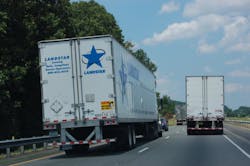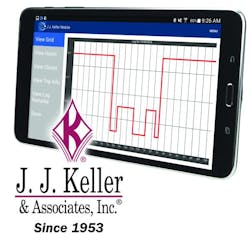So obviously the talk continues apace within the industry regarding the possibility of delaying the still highly controversial electronic logging device (ELD) mandate via legislative action by Congress.
Right now, the betting is that this effort to delay the implementation of the mandate by two years isn’t going to fly – largely because, hello, Congress is the one that forced this mandate to be established to begin with.
“There is a lot of discussion going on and a lot of conversation going on,” noted Joseph Beacom, vice president and chief safety and operations officer for Landstar System, in the carrier’s second quarter earnings call.
“We're trying to get the guys [contracted owner-operators] to move towards implementation of ELDs by the deadline in December. We currently believe … the deadline is going to hold. We're confident that they will get them installed.”
Beacom noted, however, that the proposed legislative delay cited above coupled with a request from Congress for the Federal Motor Carrier Safety Administration (FMCSA) to conduct a review of the mandate is creating what he dubbed “a little hesitation” in the industry.
“I do think there's been some speculation as to whether or not the deadline will hold and I think there's been some indecision based on that,” Beacom pointed out.
“[But] my opinion would be is that it probably doesn't [get delayed]. And I base that on the fact that it was Congress who asked them [FMCSA] to implement it,” he stressed. “So unless there's something that comes out as to trouble with enforcement or something along those lines, I would be hard pressed to think they would defer it further.”
Photo: Sean Kilcarr/Fleet Owner
Interestingly, Beacom pointed out that 20% or so of Landstar’s contracted owner-operators – whom the carrier calls “business capacity owners” or BCOs – haven’t installed ELDs as of yet and are doing so largely to avoid cost and “inconvenience” issues.
“It's not a fear factor. It's not a productivity issue, I don't believe,” he explained.
“It's just why incur the cost or the inconvenience before I have to. And so there's that deferring the decision. It isn't something that they're not willing to do," Beacom emphasized. "It's just more a factor of seeing it as there's plenty of time and hope and maybe there's this slight chance that it gets deferred. So why go through the expense and the hassle if it does, in fact, get delayed two years? It's more of that kind of mindset that we're hearing.”
Indeed, James Gattoni, Landstar’s CEO, noted on the call that BCO productivity this year has been better than it has been in the past two years – and that’s with 75% to 80% of Landstar’s BCOs using ELDs.
“We have to go back to 2014 [as] the last time they were running the way they are running today,” he noted.
Thus it clearly seems this group of independents, at least, isn’t suffering too great a business impact from adopting ELDs. And that’s really the key to making the mandate work for truckers, according to Jason Goodrich, product manager of technology solutions at J.J Keller & Associates.
“Using is believing,” he told me. “The key is to how to find the proof in the pudding; where you can advantages by using ELDs.”
First, Goodrich stressed that there is cost of not being in compliance. For if and when the mandate goes into effect, if it is discovered that a motor carrier doesn’t have one during a roadside inspection, you can placed out of service – expensive downtime any trucker, large and small, can do without.
During a conference last year, Bill Quade, the FMCSA’s associate administrator for enforcement and program delivery, noted that there’s going to be very little wiggle room for truckers regarding ELDs. If a motor carrier is discovered without an ELD or issuing one deemed “non-compliant,” the agency plans to only provide an eight-day window from the time of the initial notice that they install compliant ELDs.“But eight days isn’t much time to select, buy and install a new ELD, especially for a large fleet,” he noted. “The regulations, however, do contain provisions that allow for waivers, and FMCSA would take such circumstances into consideration.”
Yet rather than think solely about the possible “negatives” associated with ELDs, Keller’s Goodrich told me the key is look at the short- and long-term positives they can offer. And when he said “short-term” he pointedly meant costs savings, such as with fuel tax reporting.
“Think about it: with paper logbooks, you have to reconcile the log with paper fuel receipts,” Goodrich explained. “Many times receipts get lost over the course of a 600 mile length of haul, so you end up ‘guesstimating’ the right amount.”
With ELDs, however, now you have an exact mileage count. Marry that up to electronic receipts from a fuel card program and, presto, you have far more accurate fuel tax records. Goodrich said the return on that improved accuracy alone can pay for an ELD in a year or two. “We’ve had some customers gain a return [on fuel tax reporting] in a much shorter time frame, too,” he pointed out.
Then consider the reduction in time spent on the administrative needs of paper logbooks. “Think about a driver that’s making 20 stops in a day,” Goodrich emphasized. “That’s a lot of time spent noting duty status changes by hand. With an electronic log, that goes away.”
Finally, there’s the long-term to think about, especially in terms of recruiting a new generation of drivers – ones who’ve grown up in an electronics-based world.
“My grandfather was an OTR [over-the-road] driver, so mobile apps would never have worked for him,” Goodrich said. “But today, mobile apps make sense for the younger generation. They are ordering their groceries online, order Uber via their phones. They send texts; they don’t send letters. So setting up electronic technology to collect [logbook] data automatically appeals to them. This is part of what allows [carriers] to attract a new generation into trucking.”





